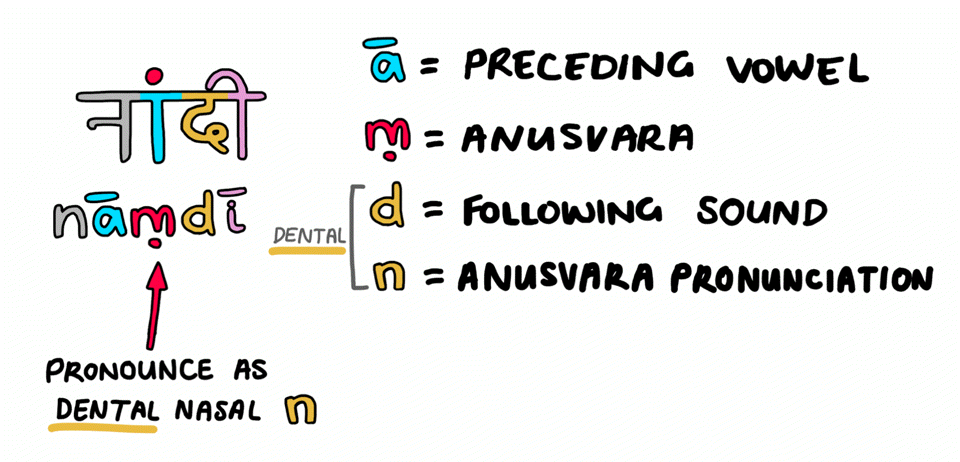[SKT] ANUSVARA
WHAT
Anusvara is a dot.
It's the smallest character in the alphabet and you'll find it hovering above the horizontal line that connects all the characters.
When it appears in a word, it sits above the character that it follows. When it's written in isolation, it usually sits above a placeholder circle (as in figure 1) or above अ (a).
In latin transliteration, it's represented by the letter m with a dot underneath (figure 1). To keep things interesting, some texts put the dot above the m. Keep your eyes peeled for both, but the dot below seems to be more common.
Fig. 1 Anusvara in devanagari (left) and transliterated in latin (right)
Anusvara never appears at the beginning of a word, so it only requires a contracted (independent) form.
PRONUNCIATION
As it turns out, no one can agree whether anusvara behaves as a vowel or a consonant. As a consequence, no one can entirely agree on its pronunciation.
You'd think this kind of discussion could be resolved by a group of congregating grammarians. Like most disputes.
Conferences are held to discuss this very thing, but scholars remain divided.
We have the camp of scholars who believe anusvara behaves as a vowel.
Those who believe it behaves as a consonant.
And those who fall somewhere in between.
I'll outline some of the different approaches to pronouncing anusvara. Some people will stick to one pronunciation, while others may combine them.
BEHAVIOUR AS A VOWEL
When anusvara is considered a vowel, it changes the pronunciation of the sound before it.
Anusvara causes the preceding vowel to be nasalised.
Fig. 2 Anusvara causing the preceding vowel to be nasalised
A common example used to illustrate this point is the pronunciation of the French "bon".
In "bon", you almost swallow the end of the word.
The nasal emphasis in anusvara isn't as strong. Let's say we half-swallow the sound. Or one-quarter.
Those in favour of anusvara being a vowel tend to be Indian scholars, Pandits and Panini himself.
BEHAVIOUR AS A CONSONANT
When anusvara is considered a consonant, it changes the pronunciation of itself.
Anusvara takes on a different pronunciation, depending on the sound that follows.
Working backwards, we identify the articulation point (velar, palatal, retroflex, dental, labial) of the sound that follows anusvara. Then we locate the nasal consonant that shares the same articulation point. And that's the winning pronunciation of anusvara.
Fig. 3 Identifying anusvara pronunciation when it behaves as a consonant
Grammatically speaking, when a sound-change is caused by the character that follows it, this is called "regressive assimilation".
This assimilation is actually quite intuitive, because we're changing anusvara so it's more similar in pronunciation to its neighbouring character.
Fig. 4 An example of anusvara changing pronunciation to share its articulation point with the following sound
Those in favour of anusvara being a consonant tend to be Western scholars.
DICTIONARY ORDER
In the alphabet line-up, anusvara comes after the vowels and before the consonants.
However.
You’ll find anusvara ordered in a dictionary EITHER according to the nasal that it refers to.
OR, if it precedes a semivowel or sibilant, anusvara will be ordered before क (k).
OPTIONAL WRITING CONVENTION
While we're still in the depths of anusvara-consonanting, we'll briefly look at an optional writing convention that is pretty nifty and efficient.
As discussed, when anusvara is behaving as a consonant, it takes on the nasal that corresponds with the following character (figure 3).
In this context, it's possible to sub-in an anusvara any time a nasal appears before a "stop" consonant.
Picture doing a find+replace across spacetime, searching for all nasals appearing before a "stop", and replacing them with anusvaras. That's what we're talking about.
Then, to get the nasal back, you take a walk through the flow chart (figure 3) and turn the anusvara back into the nasal you started with.
For the purposes of this explanation, I've taken you from nasal, to anusvara, and back to nasal. Which seems like the opposite of efficient.
But in practical use, you would simply start with an anusvara, and have the knowledge to arrive at the nasal.
This isn't a common way of writing Sanskrit, but it is an optional variation on the writing convention.
SUMMARY
There are a range of ways to pronounce this tiny controversial character.
For the most part, we can be reasonably confident it will involve some nasalisation.
Either in nasalising the preceding vowel or replacing anusvara with one of the nasal consonants.
Nothing settles controversy like diverse nasalisation.







